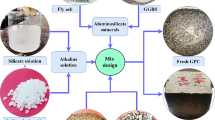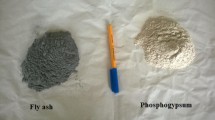Abstract
In this work, compressive strength of lightweight geopolymers produced by fine fly ash and rice husk–bark ash together with palm oil clinker (POC) aggregates has been investigated experimentally and modeled based on artificial neural networks. Different specimens made from a mixture of fine fly ash and rice husk–bark ash with and without POC were subjected to compressive strength tests at 2, 7, and 28 days of curing. A model based on artificial neural networks for predicting the compressive strength of the specimens has been presented. To build the model, training and testing using experimental results from 144 specimens were conducted. The data used in the multilayer feed-forward neural networks models are arranged in a format of six input parameters that cover the quantity of fine POC particles, the quantity of coarse POC particles, the quantity of FA + RHBA mixture, the ratio of alkali activator to ashes mixture, the age of curing and the test trial number. According to these input parameters, in the neural networks model, the compressive strength of each specimen was predicted. The training and testing results in the neural networks model have shown a strong potential for predicting the compressive strength of the geopolymer specimens in the considered range.








Similar content being viewed by others
Change history
10 February 2021
A Correction to this paper has been published: https://doi.org/10.1007/s00521-020-05660-6
References
Durant AT, MacKenzie KJD (2011) Synthesis of sodium and potassium aluminogermanate inorganic polymers. Mater Lett 65:2086–2088
Lloyd RR, Provis JL, van Deventer JSJ (2009) Microscopy and microanalysis of inorganic polymer cements. 1: remnant fly ash particles. J Mater Sci 44:608–619
Kumar S, Kumar R, Mehrotra SP (2010) Influence of granulated blast furnace slag on the reaction, structure and properties of fly ash based geopolymer. J Mater Sci 45:607–615
Álvarez-Ayuso E, Querol X, Plan F, Alastuey A, Moreno N, Izquierdo M, Font O, Moreno T, Diez S, Vázquez E, Barra M (2008) Environmental, physical and structural characterisation of geopolymer matrixes synthesised from coal (co-)combustion fly ashes. J Hazard Mater 154:175–183
Sata V, Jaturapitakkul C, Kiattikomol K (2007) Influence of pozzolan from various byproduct materials on mechanical properties of high-strength concrete. Constr Build Mater 21(7):1589–1598
Tangchirapat W, Buranasing R, Jaturapitakkul C, Chindaprasirt P (2008) Influence of rice husk—bark ash on mechanical properties of concrete containing high amount of recycled aggregates. Constr Build Mater 22(8):1812–1819
Nazari A, Bagheri A, Riahi S (2011) Properties of geopolymer with seeded fly ash and rice husk bark ash. Mater Sci Eng A 528:7395–7401
Mohammed BS, Al-Ganad MA, Abdullahi M (2011) Analytical and experimental studies on composite slabs utilising palm oil, clinker concrete. Constr Build Mater 25:3550–3560
Pala M, Ozbay O, Oztas A, Yuce MI (2005) Appraisal of long-term effects of fly ash and silica fume on compressive strength of concrete by neural networks. Construct Build Mater 21(2):384–394
Pak J, Jang J, Bhadeshia HKDH, Karlsson L (2009) Optimization of neural network for Charpy toughness of steel welds. Mater Manuf Process 24:16–21
Cottrell GA, Kemp R, Bhadeshia HKDH, Odette GR, Yamamoto T (2007) Neural network analysis of Charpy transition temperature of irradiated low-activation martensitic steels. J Nucl Mater 367–370:603–609
Pacheco-Togal F, Castro-Gomes J, Jalali S (2007) Investigation about the effect of aggregates on strength and microstructure of geopolymeric mine waste mud binders. Cem Concr Res 37(6):933–941
Pacheco-Torgal F, Castro-Gomes JP, Jalali S (2005) Studies about mix composition of alkali-activated mortars using waste mud from Panasqueira. In: Proceedings of the engineering conference, University of Beira Interior, Covilha, Portugal
Bakharev T (2005) Geopolymeric materials prepared using Class F fly ash and elevated temperature curing. Cem Concr Res 35:1224–1232
Chindaprasirt P, Chareerat T, Sirivivatnanon V (2007) Workability and strength of coarse high calcium fly ash geopolymer. Cem Concr Comp 29:224–229
Naji Givi A, Abdul Rashid S, Nora A. Aziz F, Mohd Salleh MA (2010) Assessment of the effects of rice husk ash particle size on strength, water permeability and workability of binary blended concrete, Constr Build Mater 24(11): 2145–2150
Fernandez-Jimenez A, Garcia-Lodeiro I, Palomo A (2007) Durability of alkali-activated fly ash cementitious materials. J Mater Sci 42(9):3055–3065
Topcu IB, Karakurt C, Sarıdemir M (2008) Predicting the strength development of cements produced with different pozzolans by neural network and fuzzy logic. Mater Des 29:1986–1991
Ince R (2004) Prediction of fracture parameters of concrete by artificial neural networks. Eng Fract Mech 71(15):2143–2159
Sarıdemir M, Topcu IB, Ozcan F, Severcan MH (2009) Prediction of long-term effects of GGBFS on compressive strength of concrete by artificial neural networks and fuzzy logic. Constr Build Mater 23:1279–1286
Liu SW, Huang JH, Sung JC, Lee CC (2002) Detection of cracks using neural networks and computational mechanics. Comput Meth Appl Mech Eng 191(25–26):2831–2845
Gunaydın HM, Dogan SZ (2004) A neural network approach for early cost estimation of structural systems of building. Int J Proj Manag 22(7):595–602
Suratgar AA, Tavakoli MB, Hoseinabadi A (2005) Modified Levenberg–Marquardt method for neural networks training. World Acad Sci Eng Technol 6:46–48
Nazari A, Riahi S (2011) Artificial neural networks to prediction total specific pore volume of geopolymers produced from waste ashes. Neural Comput Appl. doi:10.1007/s00521-011-0760-x
Author information
Authors and Affiliations
Corresponding author
About this article
Cite this article
Nazari, A. RETRACTED ARTICLE: Artificial neural networks application to predict the compressive damage of lightweight geopolymer. Neural Comput & Applic 23, 507–518 (2013). https://doi.org/10.1007/s00521-012-0945-y
Received:
Accepted:
Published:
Issue Date:
DOI: https://doi.org/10.1007/s00521-012-0945-y




